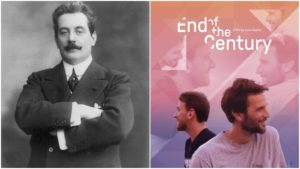
Opera Meets Film: How an Aria from ‘Turandot’ Can Take on Contrasting Meaning in ‘End of the Century’
By David Salazar“Opera Meets Film” is a feature dedicated to exploring the way that opera has been employed in cinema. We will select a section or a film in its entirety, highlighting the impact that utilizing the operatic form or sections from an opera can alter our perception of a film that we are viewing. This week’s installment features Lucio Castro’s “End of the Century.”
Spoilers Ahead!
During “Signore ascolta” in Puccini’s “Turandot,” Liù implores Calaf to reconsider his decision to risk his life for a faint dream. She wants him to come to terms with the potential harsh reality he will leave behind for his father and for her, a loyal servant who has always loved him.
But Calaf, stuck in his dream, moves forward with his goal of winning the elusive princess and living out his troubled fantasy.
The aria pops up in “End of the Century,” in many ways echoing the opera’s initial meaning.
The story centers on Ocho, a lonely man taking some time off in Barcelona. He encounters Javi one night and the two wind up spending an entire day together. During the course of that day, they discover that they’ve seen each other before and from there we jump to a memory from 20 years prior.
During this initial meeting, Ocho happens upon Sonia, a singer practicing Liù’s aria. Ocho observes her from another room, Sonia singing in the foreground with him firmly in the background. The camera lingers on the end of her performance, emphasizing a sense of longing in Ocho that has been present from the very opening of the film. In that opening section, the camera wanders with him, stares at people from his balcony, focuses on the scenery around the city. It creates a sense of loneliness and longing that fittingly comes to a head in this first appearance of the aria. Moments later, Ocho and Javi will have their very first sexual encounter 20 years ago.
After remembering their experience together, Javi and Ocho part ways. And then something strange happens – Ocho walks back into his apartment to find Javi there living with them. Suddenly the two have a life together. They have a child together. Ocho is no longer lonely.
As he walks through the streets with his infant daughter, he crosses paths with Sonia singing that same aria to passerbys. This image contrasts greatly with the other moment where she sang the aria. Where that sequence was shot with tighter images, here Sonia’s performance is visualized using wide shots, creating openness and even more tranquil feel. The music doesn’t have the same melancholic charge of that opening sequence. This is furthered by Ocho’s smile toward Sonia as he walks by with the child, who further softens this idyllic moment. Ocho even notes that Sonia is just practicing outside again, making this seem very much like a usual, run-of-the-mill occurrence.
That isn’t to say that this is an empty moment at all, but simply a tender and hopeful one; a moment where the same piece of music can take on a completely different meaning thanks to the power of cinema.
But the truth we learn is that this moment was nothing more than a dream – Ocho’s dream. In his fantasy, that aria which emphasized his loneliness in the opening flashback loses that painful potency and just becomes a moment of abstract beauty in an open space. And when we draw that connection at the end of the film, that first sequence between Sonia and Ocho is all the more crucial and emotionally potent. Suddenly, in the grand scheme of the film and its story, Ocho’s connection with Sonia’s aria on opposite sides of a doorway mirrors Ocho’s social alienation and his sense of longing.
Liù’s story in “Turandot” ends tragically. She kills herself to save Calaf and keep his dream intact. Ocho doesn’t kill himself in the film, but when he returns to his reality after living in his dream (and letting the audience live in his dream) for a few minutes, you definitely feel the death of something in his life – hope for a love reborn in him.
Categories
Opera Meets Film

